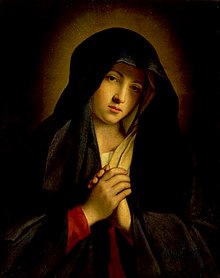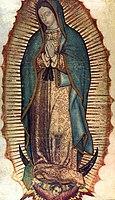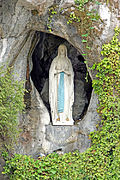Mary, mother of Jesus

In Abrahamic religions, Mary (Judeo-Aramaic מרים Maryām; Arabic: مريم (Maryam); Septuagint Greek Μαριαμ, Mariam, Μαρια, Maria; Syriac: Mart Maryam) was the mother of Jesus. Her story is told in the New Testament of the Bible.
Mary in the Bible
[change | change source]Christian beliefs about Mary are based on the Bible. The Gospel of Matthew and the Gospel of Luke say that Mary was a young woman who was engaged to be married to a man called Joseph. The Gospel of Luke says that the angel Gabriel came to Mary to tell her that she would give birth to a son. The angel told Mary that she should call her son Jesus. The angel also said that Jesus would save people from their sins.
Mary asked the angel how she could be pregnant, since she was a virgin. The angel told her that God had made her pregnant through a miracle.
In the sixth month, the angel Gabriel was sent from God to a town of Galilee called Nazareth, to a virgin betrothed to a man named Joseph, of the house of David, and the virgin’s name was Mary. And coming to her, he said, “Hail, favored one! The Lord is with you.” But she was greatly troubled at what was said and pondered what sort of greeting this might be. Then the angel said to her, “Do not be afraid, Mary, for you have found favor with God. Behold, you will conceive in your womb and bear a son, and you shall name him Jesus. He will be great and will be called Son of the Most High, and the Lord God will give him the throne of David his father, and he will rule over the house of Jacob forever, and of his kingdom there will be no end.” But Mary said to the angel, “How can this be, since I have no relations with a man?” And the angel said to her in reply, “The holy Spirit will come upon you, and the power of the Most High will overshadow you. Therefore the child to be born will be called holy, the Son of God. And behold, Elizabeth, your relative, has also conceived a son in her old age, and this is the sixth month for her who was called barren; for nothing will be impossible for God.” Mary said, “Behold, I am the handmaid of the Lord. May it be done to me according to your word.” Then the angel departed from her.[1]
According to the law that Israelites follow, Joseph had the right to divorce Mary publicly, but he did not. In a dream Joseph was told that Mary was conceived by the Holy Spirit.
At this time, the Roman Emperor, Caesar Augustus, made a law that everyone in the Roman Empire had to pay a tax. Everyone had to go back to the town that their family came from, to have their name put on the tax lists. Joseph came from Bethlehem, which was called The City of David. So Joseph took Mary to Bethlehem. There, she gave birth to the baby, Jesus. She gave birth in an animal shed, because Mary and Joseph could not find a room to stay in.
Thirty-three years later, Jesus was killed by crucifixion. Many of Jesus' apostles were scared of the Roman soldiers and ran away. However, Mary stood by the cross and was with Jesus when he died. As he was dying, he told the young disciple John to care for Mary as if she was his own mother, and the words were "Woman, this is your son. This is your mother". On the third day after Jesus' death, Mary went to Jesus' tomb with other women. They saw that the stone was rolled away from the tomb, and his body was gone. An angel told the women that Jesus had risen and was alive.
Mary continued to meet with the early church after the Ascension of Jesus. (Acts 1:14)
Mary in Islam
[change | change source]The Qur'an says that she was a virgin when she gave birth to Jesus and so Muslims honor Jesus as a great prophet.
Giving honor to Mary
[change | change source]Mary is given honor in the Christian faith. She is especially honored as "the Mother of God" in the Roman Catholic Church. She is also honored as "Theotokos" (roughly translated as "the one who gave birth to God") in the Eastern Orthodox Church. In Christianity, Jesus is thought to be both fully God and fully man.
Christians do not worship Mary, because they believe that only God should be worshipped. However, some Christians, mainly Roman Catholics and Orthodox Christians, venerate her. That means that they pray to her and respect her acceptance of God's will by willingly giving birth to Jesus.
Mary is often called "the Blessed Virgin Mary" by Roman Catholics. There are many feast days that honor the Virgin Mary. For example, the Nativity of the Blessed Virgin, on 8 September, honors her birth. Catholics also celebrate the Immaculate Conception, and Mary as Queen of Heaven on August 22. There is some confusion about the Immaculate Conception. Many think this is the same as the virgin birth of Jesus, but the Catholic teaching of Immaculate Conception is that Mary herself was born without sin.
Christian art often shows the Virgin Mary. Many paintings show Mary with the baby Jesus. These paintings are known as Madonna and Child pictures.
Many people who pray through Mary use a prayer called the Hail Mary. The first part of the prayer honors Mary: "Hail Mary, full of grace, the Lord is with thee. Blessed art thou amongst women, and blessed is the fruit of thy womb, Jesus." The second part of the prayer asks for Mary's help: "Holy Mary, Mother of God, pray for us sinners, now and in the hour of our deaths. Amen."
The Hail Mary is repeated many times in the Rosary, a special devotion recommended by the Catholic Church including the most important prayers while thinking about the main events in the lives of Jesus and Mary.
Protestants believe that Roman Catholics and Orthodox give Mary too much honor. Since the title "Mother of God", the Immaculate Conception and the Assumption of Mary are all teachings that are not found in the Bible, Protestants don't accept them. The Assumption of Mary is the teaching that Mary was taken up to heaven without dying. [2] Protestants believe that we can pray directly to God through Jesus, and do not need Mary or other saints to intercede for us.
- Pilgrimages
-
The Theotokos of Tikhvin
-
Our Lady of Guadalupe Mexico
-
Our Lady of Lourdes France
-
Our Lady of Fatima Portugal
Related pages
[change | change source]References
[change | change source]- ↑ "The Gospel of Luke". USCCB.org (Chapter 1:26-38). 2016 [AD 101]. chapter 1, verse 26-38. Retrieved 6 March 2016.
- ↑ "Munificentissimus Deus (November 1, 1950) | PIUS XII".





